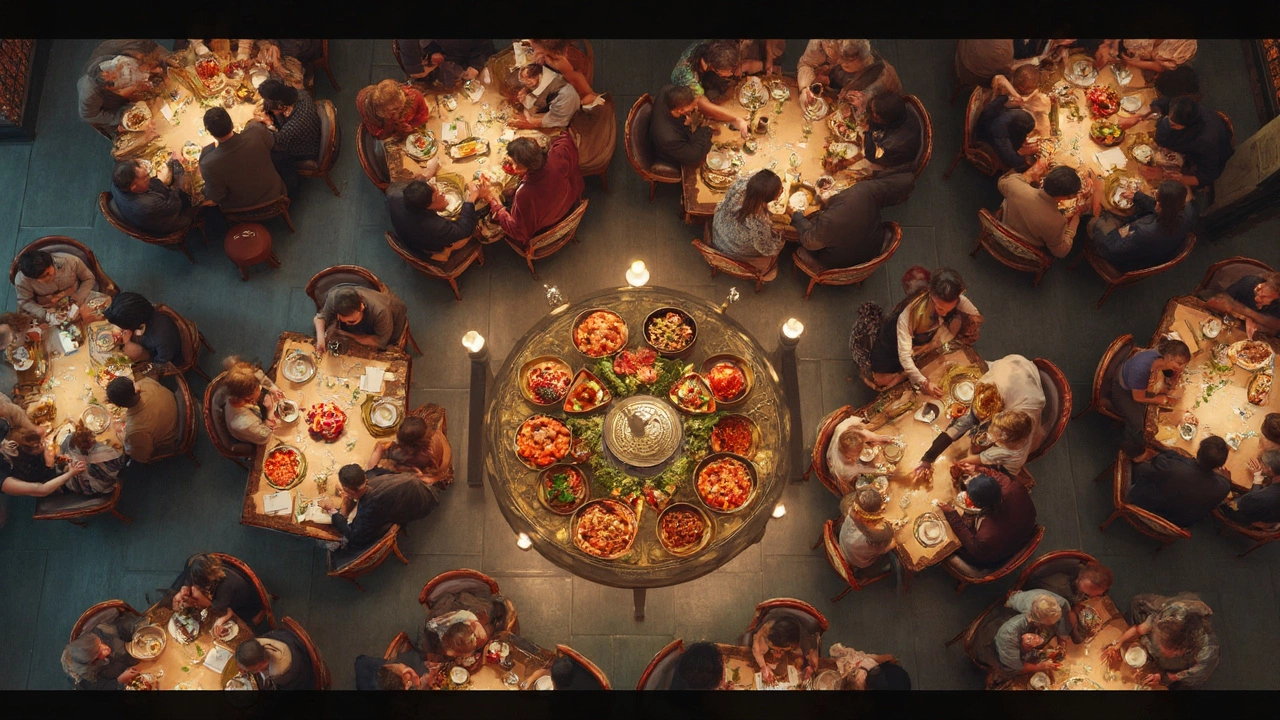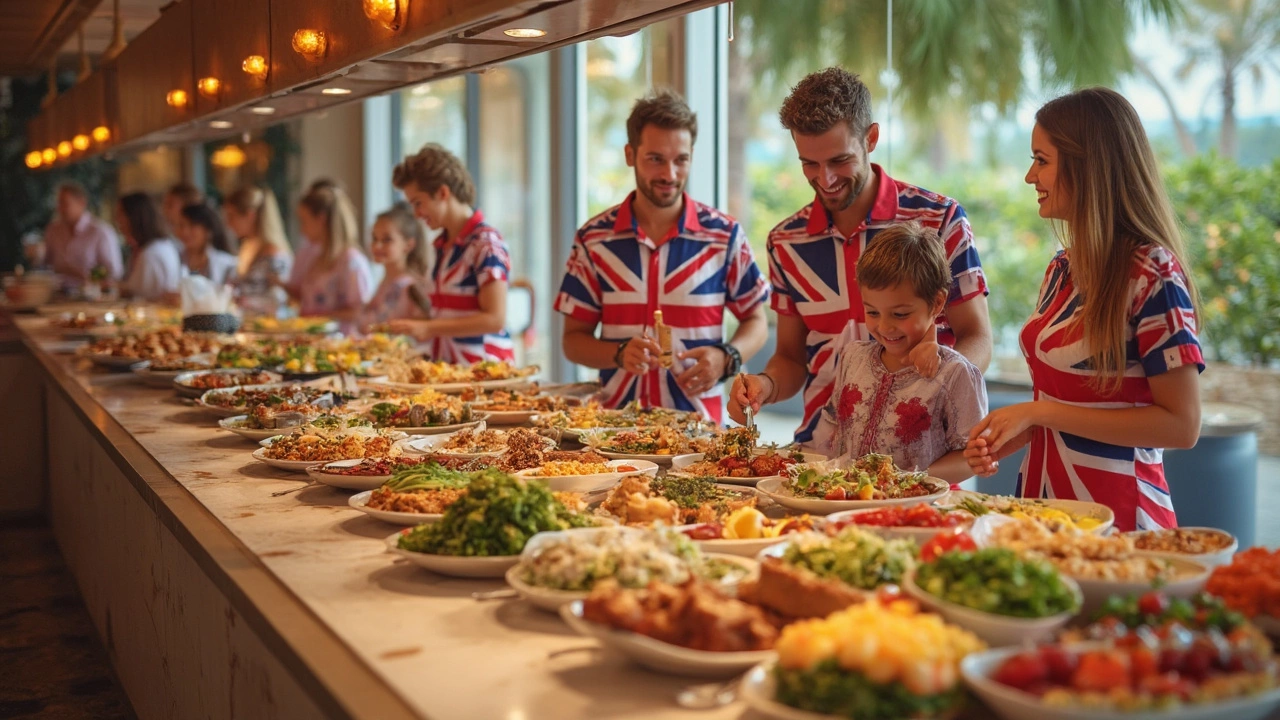Thinking of booking an all-inclusive resort because you love the idea of endless meals and never checking a dinner bill? You're not alone. The promise of “all you can eat” is a big reason why these places are so popular with families, couples, and even solo travelers who want to keep things simple. But what does all-inclusive actually cover when it comes to food—and where do the limitations sneak in?
It sounds like a dream: breakfast buffets that don’t quit, poolside snacks whenever you feel like it, dinners at fancy restaurants without worrying about the price tag. In reality, most all-inclusives do offer almost non-stop food, often serving something around the clock. Still, not every bite and sip is included. Upscale cuts of steak, lobster dinners, and premium drinks? Those can land you an unexpected charge on check-out if you’re not careful.
Buffets usually are totally fair game, and casual bite spots like beach grills or snack bars tend to be, too. But if you want à la carte dining—like sushi spots or fine steak houses—you might need to make reservations or pay a bit extra. That’s where it pays to read the fine print before you travel, so you don’t miss out on something you’ve been dreaming about… or get surprised by a bill when you thought you’d paid up front.
- What Does 'All-Inclusive' Really Mean?
- What's Included in the 'All You Can Eat' Promise?
- Where You Might Need to Pay Extra
- Tips to Get the Most from Resort Buffets
- Surprising Rules and Hidden Limits
What Does 'All-Inclusive' Really Mean?
When you book a all-inclusive resort, you’re usually paying a flat rate up front. This covers your room, most meals, snacks, and local drinks—coffee, soda, beer, and certain cocktails—for your whole stay. The idea is that you won’t have to keep pulling out your wallet or adding up food costs, which is a relief if you’re traveling with kids or a big group.
Most resorts offer at least three main meals daily (breakfast, lunch, and dinner) at their buffet or main restaurants. Snacks, like pizzas, ice cream, burgers, and even midnight bites, are often available almost all day. There’s usually a bar menu included, so you can grab a drink at the pool or beach without worrying about the price.
But not everything is always unlimited and included. Here are some key things that all-inclusive resorts usually include:
- Room accommodation
- All main buffet meals
- Snacks between meals
- Select alcoholic and non-alcoholic drinks
- Most on-site sports and activities
- Daily entertainment and shows
Some resorts step it up with extras, like non-motorized water sports or even kids’ clubs, rolled into your rate. Just don’t assume literally everything is part of the deal—things like spa treatments, room service, or exclusive dinners often cost extra.
Here’s a quick rundown of what a typical all-inclusive package can look like at a popular Caribbean resort:
| Included | Not Included |
|---|---|
| Buffet meals | Lobster/fine dining |
| Local beer & basic cocktails | Premium spirits/wine |
| Soft drinks | Spa treatments |
| Pool games & shows | Motorized water sports |
The promise of all you can eat sounds amazing—but check the resort’s official list before you book so you know exactly what’s part of the package, and what’s not.
What's Included in the 'All You Can Eat' Promise?
Most people picture a resort buffet loaded with options: pancakes and eggs in the morning, tacos for lunch, prime rib for dinner, endless desserts, and stations for picky eaters or foodies. That’s usually spot on. All-inclusive resorts commonly offer unlimited food at their main buffets, and you can go back for as many helpings as your vacation appetite allows. Snacks are easy to find at poolside bars, beach grills, and sometimes in your room’s minibar if it’s restocked daily (check before you dig in, because not all resorts include the minibar treats).
Here's what your daily eating might look like at the average all-inclusive resort:
- Buffets for breakfast, lunch, and dinner with a wide variety of dishes (think: eggs, fresh fruit, pastries, salads, pasta, roast meats, themed dinners—it's usually a huge spread).
- Snack bars or grills for casual, no-reservation bites like burgers, pizza, nachos, and fries, especially near the pool or beach.
- Drinks—soft drinks, house beer, wine, and basic cocktails are nearly always included, but fancy top-shelf liquor can cost extra.
- Room service, sometimes 24/7, but sometimes limited to certain hours or with a smaller menu.
Some resorts also have a few à la carte restaurants—Italian, Asian, seafood, and more. They’re part of the all you can eat package as long as you reserve ahead or follow the policy (like one dinner per specialty restaurant per stay). Not all à la carte menus are open for unlimited visits, though. It’s smart to make reservations as soon as you check in—slots can fill up fast.
Here’s a quick look at what’s nearly always included, and what typically isn’t:
| Usually Included | Usually Not Included |
|---|---|
| Main buffet meals | Lobster, premium cuts of steak |
| Snacks and casual dining | Specialty coffees (Starbucks, etc.) |
| House drinks and simple cocktails | Top-shelf spirits, bottled wine |
| Soft serve or basic desserts | Fancy pastries, certain ice creams |
| Some à la carte restaurants (w/ reservation) | Romantic/private dinners |
Watch out for small print about limits. For example, you might find out you get three à la carte restaurant bookings during your week, but the rest is all buffet. Ask at check-in if you’re not sure what’s covered, or look for a list in your welcome info. That’s how you avoid missing out or getting a charge for something you thought was part of the deal.

Where You Might Need to Pay Extra
This is the part where folks get tripped up at all-inclusive resorts. Not every food option is really “all you can eat.” Sure, main buffets and poolside grills are usually included, but special stuff can cost more. Here are some things that might add to your bill:
- Premium restaurants: Most places include a few buffet and à la carte spots, but anything labeled “gourmet” or “specialty” might require a reservation, a surcharge, or both. Think lobster tail, Kobe-style beef, or that fancy sushi restaurant on property.
- Room service: Sometimes it’s free, sometimes there’s a delivery charge. Double-check when you crave late-night fries.
- Top-shelf alcohol: House wine and local beer? Usually included. But order champagne, craft cocktails, or imported whisky, and you could see an extra charge. The bar menu will spell it out—don’t just assume it’s covered.
- Mini-bar upgrades: Water and soda are pretty standard, but if you want it restocked with M&Ms, Pringles, or premium booze, there might be a fee each time.
- Private dinners: Beachside romantic dinners or chef’s table experiences sound great but usually cost extra—even at the most “all-in” places.
A 2024 study by Resort Addict found about 80% of Caribbean all-inclusive resorts included unlimited buffet dining but only 40% included unlimited à la carte restaurants or all-day room service. Here’s a quick breakdown:
| Service | % Included in All-Inclusive |
|---|---|
| Unlimited buffets | 80% |
| À la carte restaurants | 40% |
| All-day room service | 20% |
| Top-shelf spirits | 15% |
The key is to read all the fine print or ask your travel agent what’s included. If a menu has prices listed, that means you’ll pay, even with a wristband. Just remember—if you’re craving something fancy, it pays to double check. That way, you can enjoy your all you can eat perks without fearing surprise charges at check-out!
Tips to Get the Most from Resort Buffets
Walking into a resort dining area and seeing tables piled high with food is the main draw of many all-inclusive resorts. Still, there’s a knack to getting your money’s worth—and actually enjoying it. Here’s how you do it smartly, not just hungrily.
- Don’t rush the first round. Walk the buffet before grabbing a plate. Check what’s on offer and see where the best stuff is hiding. A lot of resorts rotate dishes daily or even between lunch and dinner, so it pays to plan instead of piling on things you'll regret.
- Go for the made-to-order stations. Most hotel buffet spreads have at least one chef-run counter—think omelets in the morning, or pasta and tacos at lunch and dinner. These are usually fresh, customizable, and way better value than the stuff that's been sitting under a heat lamp.
- Avoid filling up on bread and cheap fillers. It’s tempting to start with pastries or fries, but those fill you up fast. Save space for pricier items, especially seafood or special local dishes. If you spot shrimp, smoked salmon, or carving stations, that’s where your money’s going.
- Time it right. If you want to avoid crowds and get the freshest options, go to buffets right when they open. Food is just coming out, and you won’t have to elbow through lines. Especially at dinner, this tip makes a difference if you’re trying to get that perfect slice of roast or first dibs on dessert.
- Signal any dietary needs early. Most all you can eat buffets label allergens, but if you’re vegan, gluten-free, or have other restrictions, chat with the staff. Resorts are used to this, and they’ll often bring you something from the kitchen or point out the best options.
Here’s a sneak peek at how meal variety at popular all-inclusive resorts stacks up:
| Resort Brand | Typical Buffet Stations | Specialty Nights |
|---|---|---|
| Sandals | Seafood, Pasta, Grill, Salad Bars | Caribbean, Italian, BBQ |
| RIU | Fresh Fruit, International, Live Cooking | Mexican, Asian, Themed Desserts |
| Club Med | Cheese, Deli, Fresh Baked Goods | French Night, Sushi, Local Cuisine |
Don’t forget—if you really love something, it’s fine to grab seconds (or thirds). Just watch how you mix things on your plate, so the flavors don’t clash. Grabbing smaller amounts means you can sample more, too. And if you want photos for Instagram, time your trip to the buffet before everyone else digs in—the spread looks way better at the start!

Surprising Rules and Hidden Limits
This is where things get a little tricky at all-inclusive resorts. The idea is unlimited food, but there are quirks and small print that can catch you by surprise. For starters, those fancy à la carte spots? Many resorts limit how many times you can eat there—sometimes to just one or two visits per week. If you’re picturing sushi every night, some places will tell you to spread the love at the buffet instead.
Forgot your wristband? Bad news. Most all-inclusive hotels require you to wear a resort wristband at all times to show you’re a guest. No wristband, no service—whether you’re at the snack bar or the steakhouse. Some places are strict: lose it and you could be charged for a replacement.
Room service sounds great, right? At a lot of all-inclusive resorts, it’s only free during certain hours or might just include a smaller, special menu. Craving midnight nachos? Some resorts will charge you for late-night delivery. And mini-bars aren’t always bottomless either. Housekeeping might refill daily, but only with standard options—think basic sodas and maybe local beer. Anything fancier might mean extra charges.
Even at the main buffet, you can spot some rules. It’s pretty common for premium items like shrimp, crab, or steak to show up only one night per week, or they might be “chef’s special” and run out quickly. Some places even set limits per person on shellfish or steaks, a trick they use to keep costs down.
Want to see some clear-cut examples? Check out this table with limits found at popular brands:
| Resort Chain | À La Carte Visits | Mini-Bar Rules | Room Service |
|---|---|---|---|
| RIU Hotels | 2 per week, with reservation | Restocked once a day (beer & soda only) | 24/7, but some menu items extra $ |
| Sandals | No hard limit, but reservations required | Restocked daily, standard drinks only | Included, but limited menu after midnight |
| Hyatt Ziva | 3 per week | Restocked daily; special requests extra $ | Included, limited overnight |
Here’s another curveball: some all-inclusive resorts have a dress code for certain restaurants. Flip-flops and swimwear are a no-go for dinner. Also, bringing outside snacks or drinks into restaurants, even from another spot on the property, is usually not allowed.
So when you see "all you can eat," just remember—there are more rules than most people expect. Scan your resort’s details before you book, and always double-check the fine print when you get your welcome packet. It’s worth it to avoid those annoying surprises in paradise.
